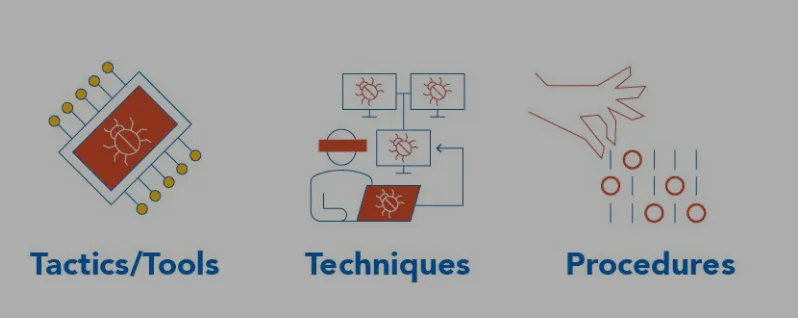Introduction:
Cybercrimes are now very sophisticated and frequently encountered problems in the contemporary digital age; therefore, they present much danger to organizations, governments, and individuals across the globe. To effectively fight this threat it is crucial to investigate the cyberattacks anatomy, break the enemies tactep, technique and procedures (TTPs). This article is an attempt to discover the complex process of cyberattacks, to see how the attackers are using their methods to infiltrate systems, to compromise data and to evade detection.
Understanding Cyberattack Tactics:

Hacking techniques range from all across the spectrum of illegitimate actions which aim at discovering security flaws in cyberspace. Common tactics include:
Phishing: As an example, attackers send deceptive emails, messages, or websites that pop up when users browse web pages. Malicious users imbed these pages to steer users towards granting sensitive information and to install malware.
Malware: Harmful programs, for instance, viruses, worms, Trojans, and ransomware, are used to attack systems, steal data, or even disrupt the operations.
Exploitation of Vulnerabilities: The crooks/attackers penetrate the software/operating systems or network protocols that contain the vulnerabilities to run malicious code, scan the network for access, or escalate privileges.
Social Engineering: Misleading methods by an offender, such as changing the identity or baiting, are applied to induce disclosure of the private information or exposure to potential data security threats.
Examining Cyberattack Techniques:
Within each tactic, cyber attackers deploy specific techniques to achieve their objectives:
Spear Phishing: The targeted phishing attacks which are designed in a way that they are customized for specific individuals or organizations to increase the chance of success.
Remote Code Execution: Usage of flaws to execute malicious code at a remote system, with further consequences of stealing personal information, modifying or deleting it or using vulnerable systems to launch further attacks to wider audience.
Credential Theft: We steal user credentials either by using the techniques mentioned above like password spraying, credential stuffing, or keylogging so as to gain access to the accounts without appropriate authentication.
Lateral Movement: After getting into the network, attackers will then laterally move to explore and compromise other systems, up their privileges and expand their foothold.
Read Also: Cloud Migration Blueprint: Building Your Path to Hybrid Cloud
Unraveling Cyberattack Procedures:
Cyberattack procedures outline the step-by-step processes followed by threat actors to execute attacks effectively:
Reconnaissance: Attackers gather intelligence on target systems, networks, and personnel. They use this information to identify vulnerabilities and tailor attack strategies to the specific situation.
Weaponization: Developing or buying a dishonest utilities, such as exploits and phishing templates, which then perform attacks by delivering payloads.
Delivery: Doing it by mailing malicious payloads via email scus, infected sites, removable mednie, or using compromised network services.
Exploitation: Exploitation of vulnerabilities or human mistakes for the first entry and establishment of a foothold into the target systems
Command and Control: The attacker establishes a communication channel with compromised systems through remote control. This channel is utilized to exfiltrate data from compromised systems to the attacker’s infrastructure. It typically connects to a command and control (C2) server.
Persistence: Cybercriminals often leave backdoors, create fake user accounts, or modify system configurations to maintain unauthorized access to hacked systems. This allows them to easily re-enter the compromised systems in the future.
Evasion: Criminals use techniques like obfuscating malware, encrypting communication, and spoofing IP addresses to evade security defenses. These methods help them conceal their activities from detection effectively.
Conclusion:
Understanding cyberattacks anatomy is crucial for addressing the pervasive threat they present to global organizations, governments, and individuals. This knowledge plays a vital role in combating cyber threats effectively. The cyber-thugs employ phishing to deceive and introduce malware, exploiting vulnerabilities to compromise data in systems. Their tactics involve using phishing for deception and exploiting vulnerabilities to compromise data within systems. By deconstructing the methods, tactics and procedures (TTPs) of the adversaries, we will raise awareness of looming threats. We will prevent these threats by adapting and implementing strategic agreements.
To develop resilience to cyber threats, it is crucial to implement reliable security measures and foster a culture of cybersecurity awareness. Staying informed about emerging threats is also essential in our interconnected world. Today our globally connected world is at high risk from cyberattacks which progressives faster and harder every day. Cybersecurity protects us and our digital assets from dangerous actors. Therefore, proactive defense and awareness should be our priorities. Through being aware of the latest threats, we can contribute to building a safer digital world for all. By adopting the best cybersecurity hygiene practices, we can help create a more secure online environment.

